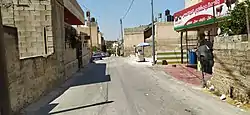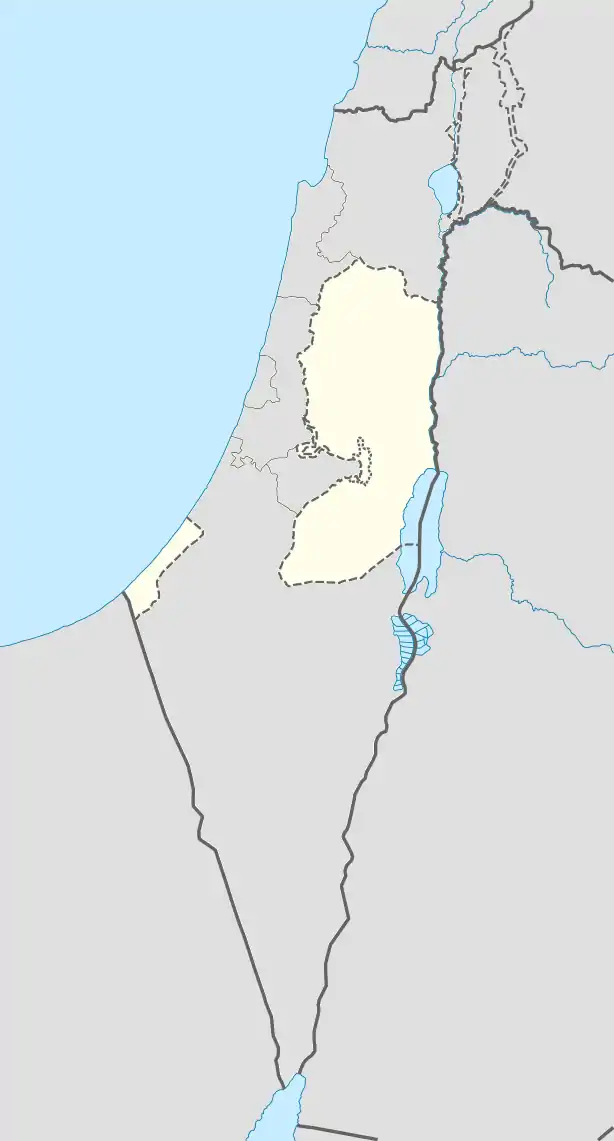Mazari an-Nubani | |
|---|---|
| Arabic transcription(s) | |
| • Arabic | مزارع النوباني |
 Mazari an-Nubani | |
 Mazari an-Nubani Location of Mazari an-Nubani within Palestine | |
| Coordinates: 32°02′58″N 35°09′57″E / 32.04944°N 35.16583°E | |
| Palestine grid | 165/161 |
| State | State of Palestine |
| Governorate | Ramallah and al-Bireh |
| Government | |
| • Type | Municipality |
| Population (2017)[1] | |
| • Total | 2,436 |
| Name meaning | "The sown land",[2] |
Mazari an-Nubani (Arabic: مزارع النوباني) is a Palestinian town in the Ramallah and al-Bireh Governorate, located 25 kilometers North of Ramallah in the northern West Bank. According to the Palestinian Central Bureau of Statistics (PCBS), the town had a population of 2,436 inhabitants in 2017.[1]
History
Mazari al-Nubani was by earlier scholars (Röhricht, Prawer and Benvenisti) identified with the Crusader village called Mezera, but newer scholars (Finkelstein et al.) disputes this.[3]
Ottoman era
In 1596 the village, under the name of Mazra'at al-'Abbas, appeared in the Ottoman tax registers as being in the Nahiya of Quds of the Liwa of Quds. It had a population of 60 households and 21 bachelors, all Muslim. Taxes were paid on wheat, barley, olive trees, vineyards and fruit trees, goats and/or beehives; a total of 6,910 akçe. 1/3 of the revenue went to a Waqf.[4][5]
In 1838 el-Mezari'a was noted as a Muslim village, part of the Beni Zeid area, located north of Jerusalem.[6]
When Guérin passed by the village in 1870, he estimated it had a population of about 600.[7] An Ottoman village list from about the same year showed Mazari with a population of 560, in 163 houses, though the population count included men only. It was also noted it was located east of Qarawat Bani Zeid.[8][9]
In 1882, the PEF's Survey of Western Palestine described the village, then called Mezrah,[2] as being of moderate size, on high ground.[10]
In 1896 the population of Mezra‘a was estimated to be about 1,008 persons.[11]
British Mandate era
In the 1922 census of Palestine conducted by the British Mandate authorities, Mazarie' al-Nubani had a population of 611 Muslims,[12] increasing in the 1931 census to 864 Muslims, in 193 houses.[13]
The 1945 statistics found 1,090 Muslim inhabitants[14] with a total of 9,631 dunam of land.[15] Of this, 7,399 were used for plantations and irrigable land, 445 for cereals,[16] while 59 dunams were classified as built-up areas.[17]
Jordanian era
In the wake of the 1948 Arab–Israeli War, and after the 1949 Armistice Agreements, Mazari Nubani came under Jordanian rule.
In 1961, the population of Mazari al-Nubani was 1,358.[18]
Post 1967
Since the Six-Day War in 1967, Mazari al-Nuban has been under Israeli occupation.
According to the Palestinian Central Bureau of Statistics (PCBS), the town had a population of approximately 2,510 inhabitants in mid-year 2006.[19]
Folklore
The local a-Nubani hamula claims to descend from Abdul Qadir Gilani, a Sufi leader who founded the Qadiri order.[20]
Footnotes
- 1 2 Preliminary Results of the Population, Housing and Establishments Census, 2017 (PDF). Palestinian Central Bureau of Statistics (PCBS) (Report). State of Palestine. February 2018. pp. 64–82. Retrieved 2023-10-24.
- 1 2 meaning "The sown land", according to Palmer, 1881, p. 239
- ↑ Röhricht, 1887, p. 200, Prawer and Benvenisti, 1970; both cited in Finkelstein, 1997, p. 464. Finkelstein found no old pottery here.
- ↑ Hütteroth and Abdulfattah, 1977, p. 114
- ↑ Toledano, 1984, p. 296, has Mazari at location 35°09′35″E 32°03′00″N.
- ↑ Robinson and Smith, 1841, vol 3, Appendix 2, p. 125
- ↑ Guérin, 1875, p. 170
- ↑ Socin, 1879, p. 157
- ↑ Hartmann, 1883, p. 107, noted 103 houses
- ↑ Conder and Kitchener, 1882, SWP II, p. 291
- ↑ Schick, 1896, p. 124
- ↑ Barron, 1923, Table VII, Sub-district of Ramallah, p. 17
- ↑ Mills, 1932, p. 50.
- ↑ Government of Palestine, Department of Statistics, 1945, p. 26
- ↑ Government of Palestine, Department of Statistics. Village Statistics, April, 1945. Quoted in Hadawi, 1970, p. 65
- ↑ Government of Palestine, Department of Statistics. Village Statistics, April, 1945. Quoted in Hadawi, 1970, p. 112
- ↑ Government of Palestine, Department of Statistics. Village Statistics, April, 1945. Quoted in Hadawi, 1970, p. 162
- ↑ Government of Jordan, Department of Statistics, 1964, p. 24
- ↑ Projected Mid -Year Population for Ramallah & Al Bireh Governorate by Locality 2004- 2006 Palestinian Central Bureau of Statistics (PCBS).
- ↑ Tal, Uri (2023). Muslim Shrines in Eretz Israel: History, Religion, Traditions, Folklore (in Hebrew). Jerusalem: Yad Izhak Ben-Zvi. p. 185. ISBN 978-965-217-452-9.
Bibliography
- Barron, J. B., ed. (1923). Palestine: Report and General Abstracts of the Census of 1922. Government of Palestine.
- Conder, C.R.; Kitchener, H.H. (1882). The Survey of Western Palestine: Memoirs of the Topography, Orography, Hydrography, and Archaeology. Vol. 2. London: Committee of the Palestine Exploration Fund.
- Dauphin, C. (1998). La Palestine byzantine, Peuplement et Populations. BAR International Series 726 (in French). Vol. III : Catalogue. Oxford: Archeopress. ISBN 0-860549-05-4.
- Finkelstein, I.; Lederman, Zvi, eds. (1997). Highlands of many cultures. Tel Aviv: Institute of Archaeology of Tel Aviv University Publications Section. ISBN 965-440-007-3.
- Government of Jordan, Department of Statistics (1964). First Census of Population and Housing. Volume I: Final Tables; General Characteristics of the Population (PDF).
- Government of Palestine, Department of Statistics (1945). Village Statistics, April, 1945.
- Guérin, V. (1875). Description Géographique Historique et Archéologique de la Palestine (in French). Vol. 2: Samarie, pt. 2. Paris: L'Imprimerie Nationale.
- Hadawi, S. (1970). Village Statistics of 1945: A Classification of Land and Area ownership in Palestine. Palestine Liberation Organization Research Centre.
- Hartmann, M. (1883). "Die Ortschaftenliste des Liwa Jerusalem in dem türkischen Staatskalender für Syrien auf das Jahr 1288 der Flucht (1871)". Zeitschrift des Deutschen Palästina-Vereins. 6: 102–149.
- Hütteroth, Wolf-Dieter; Abdulfattah, Kamal (1977). Historical Geography of Palestine, Transjordan and Southern Syria in the Late 16th Century. Erlanger Geographische Arbeiten, Sonderband 5. Erlangen, Germany: Vorstand der Fränkischen Geographischen Gesellschaft. ISBN 3-920405-41-2.
- Mills, E., ed. (1932). Census of Palestine 1931. Population of Villages, Towns and Administrative Areas. Jerusalem: Government of Palestine.
- Moudjir ed-dyn (1876). Sauvaire (ed.). Histoire de Jérusalem et d'Hébron depuis Abraham jusqu'à la fin du XVe siècle de J.-C. : fragments de la Chronique de Moudjir-ed-dyn.
- Palmer, E.H. (1881). The Survey of Western Palestine: Arabic and English Name Lists Collected During the Survey by Lieutenants Conder and Kitchener, R. E. Transliterated and Explained by E.H. Palmer. Committee of the Palestine Exploration Fund.
- Prawer, J.; Benvenisti, D. (1970). Palestine under the Crusaders. In: Amiran, D.H.K. et al., eds. Atlas of Israel. Vol. IX: 10. Jerusalem.
{{cite book}}: CS1 maint: location missing publisher (link) - Robinson, E.; Smith, E. (1841). Biblical Researches in Palestine, Mount Sinai and Arabia Petraea: A Journal of Travels in the year 1838. Vol. 3. Boston: Crocker & Brewster.
- Röhricht, R. (1887). "Studien zur mittelalterlichen Geographie und Topographie Syriens". Zeitschrift des Deutschen Palästina-Vereins. 10: 195–344.
- Schick, C. (1896). "Zur Einwohnerzahl des Bezirks Jerusalem". Zeitschrift des Deutschen Palästina-Vereins. 19: 120–127.
- Singer, A. (1994). Palestinian Peasants and Ottoman Officials: Rural Administration Around Sixteenth-Century Jerusalem. Cambridge University Press. ISBN 0-521-47679-8.
- Socin, A. (1879). "Alphabetisches Verzeichniss von Ortschaften des Paschalik Jerusalem". Zeitschrift des Deutschen Palästina-Vereins. 2: 135–163.
- Tamārī, S. (2008). Mountain Against the Sea: Essays on Palestinian Society and Culture. University of California Press. ISBN 978-0-520-25129-8.
- Toledano, E. (1984). "The Sanjaq of Jerusalem in the Sixteenth Century: Aspects of Topography and Population". Archivum Ottomanicum. 9: 279–319.
External links
- Welcome To Mazari' al-Nubani
- Survey of Western Palestine, Map 14: IAA, Wikimedia commons
